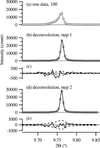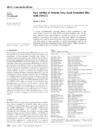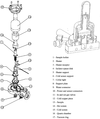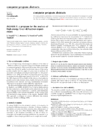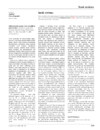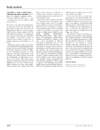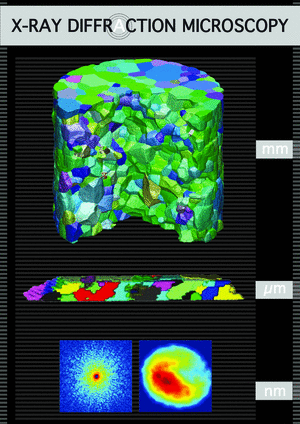issue contents
April 2003 issue
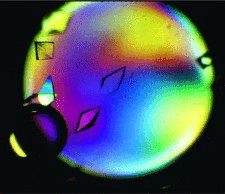
Cover illustration: Protein crystals in a 2 µl gelled microbatch drop dispensed automatically under oil. Courtesy of A. Moreno, E. Saridakis & N. E. Chayen [J. Appl. Cryst. (2002), 35, 140-142].
research papers
A method to deconvolute the instrumental aberration functions from the experimental powder X-ray data measured with a high-resolution synchrotron powder diffractometer has been developed. The effects of the diffractometer aberration and asymmetry caused by the beamline optics have been eliminated from the entire observed diffraction pattern of LaB6 powder.
A novel, fast and stable system for measuring the lattice spacing of a silicon crystal employs self selection of monochromatic X-rays by a monolithic double channel-cut crystal monochromator (MDCM), producing silicon 264 and 624 diffraction, which can lead to a stable, highly collimated and narrow-bandwidth beam. When utilizing the 264 and 624 Bragg reflections of a silicon sample, the angular distance between the two associated Bragg peaks must be extremely small, so that the diffraction angle can be determined with high precision and the traveling time from one peak to the other can be considerably reduced by the order of at least three compared with the established classical Bond method.
Topological analysis of Fourier maps, when carried out at room temperature, can provide conclusive proof of atom connectivity in crystal structure determination. Thus, topological analysis may unambiguously assign a chemical structure to a molecule by determining the number and kind of critical points in its electronic charge distribution, points where ∇ρ = 0.
The use of isotopic-substitution neutron diffraction (ISND) with combined-data-set Rietveld analysis from powder data is described, using isotopically copper-substituted tenorite (CuO) as the test case. It is found that structural model parameters are determined to a higher precision and accuracy from combined refinements compared with separate single-data-set analysis of each of the isotopically substituted samples, with decreases in estimated uncertainties typically of 30%.
The properties of an X-ray Laue-case wavefront-dividing interferometer are analysed by the time-dependent dynamical diffraction theory. The interference fringes recorded for partially coherent incident X-rays agreed well with the analysis.
A priori calculation of three-dimensional reflection boundaries for intensity integration is presented.
A new procedure for the determination of organic structures from powder diffraction data is presented. It uses direct-space techniques combined with information supplied by direct methods.
A new direct-space method for ab initio solution of crystal structures from powder diffraction data based on global minimization of Rwp and potential-energy cost functions is presented.
The fractal dimension of surface-induced aggregates of super-paramagnetic colloidal particles and the surface-tension coefficient of a ferrofluid were simultaneously obtained by non-specular X-ray reflection. The temperature variation of the fractal dimension indicated the stabilization of self-organized chain-like aggregates by the loss of branches.
A sensitive method to detect long-range strain in otherwise perfect crystalline materials is demonstrated using X-ray dynamical diffraction. A specimen is set vertically under the symmetrical Laue condition and rotated along the scattering vector.
A useful set of expressions that allow the analytical use of the stereographic Wulff net, e.g. for orientation in the Laue method, for 1-, 2- and 3-rotated cuts of single crystals fastened on a two-axis goniometric holder are derived. Application of the derived expressions in everyday crystallographic practice is illustrated by examples.
The microstructures of unmilled, ball-milled and annealed samples of a ZrO2–10 mol% anatase TiO2 mixture have been characterized by employing Rietveld's X-ray powder structure refinement methodology. The particle size, root mean square (r.m.s.) lattice strain, lattice parameters, molar fraction, etc., of individual phases have been estimated from Rietveld analysis and are utilized to interpret the results.
The new Michelson interferometer presented here is shown to perform hard X-ray Fourier spectroscopy over a range of more than 2700 orders. Based on the know-how gained in this study, an extension to 40000 orders appears feasible.
Download citation


Download citation


The thermal expansion tensor and the temperature variation of the principal structure parameters of β-NTO have been determined at five temperatures in the range 100–298 K from single-crystal X-ray diffraction data. Rigid-body analysis of the molecular thermal motion in the same range was performed using the libration and translation tensors.
An accurate method for synthesizing the instrumental line profile of high-resolution synchrotron powder diffraction instruments is presented. It is shown that the instrumental profile can be modelled by the convolution of four physical aberration functions: the equatorial intensity distribution, the monochromator and analyser transfer functions, and the axial divergence aberration function.
A practical implementation of profile fitting for the automated integration of step-scanned single-crystal diffraction data is described.
An investigation of the valence distribution in nanometric ferrites using anomalous powder diffraction is presented.
Equipment and protocols used for setting up crystallizations in 96-well plates as 100 nl drops using ink-jet technologies to dispense solutions of a wide range of viscosities are described.
An initial tranche of results from day-to-day use of a robotic system for setting up 100 nl-scale vapour-diffusion sitting-drop protein crystallizations is described.
The filtered back-projection approach is coupled with the indexing program GRAINDEX to provide three-dimensional reconstruction of grain boundaries.
A method for simultaneous structural refinement of embedded grains is presented and verified by a study of α-Al2O3.
The off-plane scatterings in one-dimensional spin echo small-angle neutron scattering as well as the inhomogeneity of the precession fields cause smearing effects in the correlation functions. Desmearing procedures developed for the traditional small-angle scattering instruments can be used to restore the true parameters of the scattering particle.
It is shown how the specific porous surface and porous volume fraction of micrometric grains can be extracted from small-angle X-ray experiments even when the thickness and compactness of the sample are unknown.
short communications
Convergent-beam monochromatic X-ray diffraction is implemented with large-angle reflective X-ray optics and a femtosecond plasma X-ray source.
pdb-mode is a set of commands for the EMACS editor that aid the processing of PDB-formatted coordinate files during structure solution, refinement and analysis.
computer programs
A new software package, called BULK, implements a bulk-solvent correction in the translation-search step of the molecular replacement packages AMoRe and CNS.
X-Cell is the first powder indexing algorithm that uses systematic absences and explicit impurity tolerance levels to perform an exhaustive search of possible unit cells. The zero-point shift is determined as part of the central successive dichotomy procedure and a multi-step approach facilitates the indexing of long and flat unit cells.
laboratory notes
A furnace covering the temperature range from 298 to 1300 K has been designed and constructed to study in situ the structural evolution of materials by using synchrotron X-ray microtomography.
computer program abstracts
The program ISOMER-X, which can be used to obtain the pseudonuclear static structure factor for disordered materials (e.g. glasses and liquids), is described.
book reviews
Free 

Free 



 journal menu
journal menu








